Risks of retreat: The path forward
18 min read
| Published on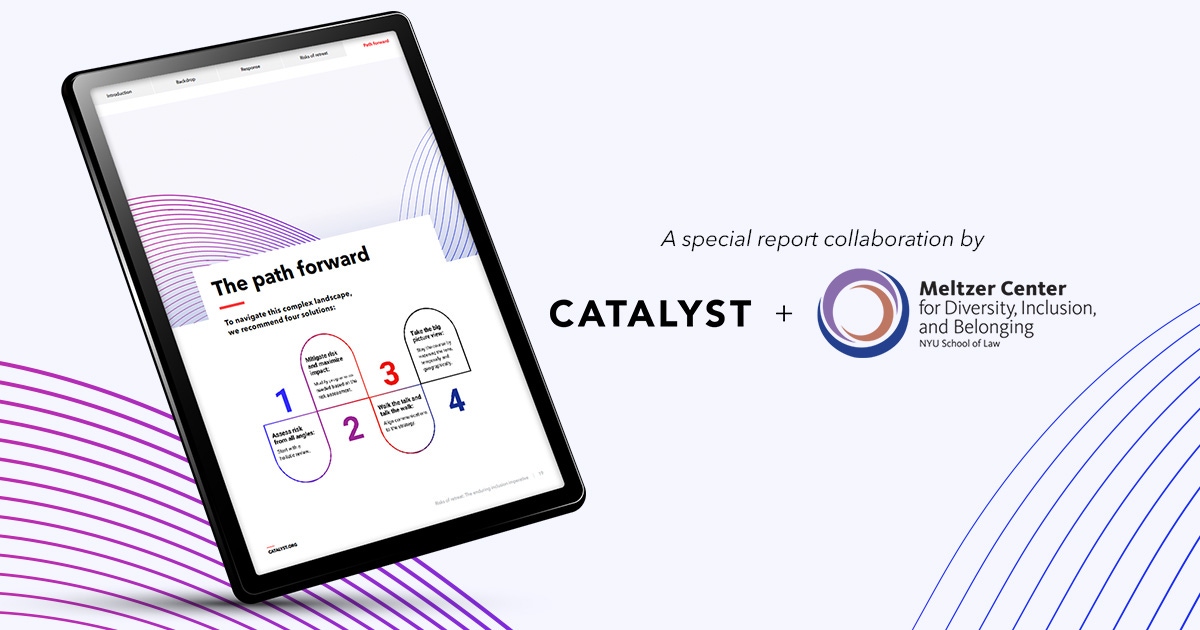
Executive summary
As organizations face significant legal and social threats to their diversity, equity, and inclusion (DEI) programs, some are considering retreating from efforts aimed at advancing fairness in the workplace. But new data from a survey of 2,500 US employees conducted by Catalyst and the Meltzer Center for Diversity, Inclusion, and Belonging in 2025 reveals significant risks of such a retreat in four areas: talent, financial, legal, and reputational.
To navigate this complex landscape, we recommend four solutions.
How to cite: Pollack, A., Glasgow, D., Van Bommel, T., Joseph, C., & Yoshino, K. (2025). Risks of retreat: The enduring inclusion imperative. Catalyst & Meltzer Center for Diversity, Inclusion, and Belonging.
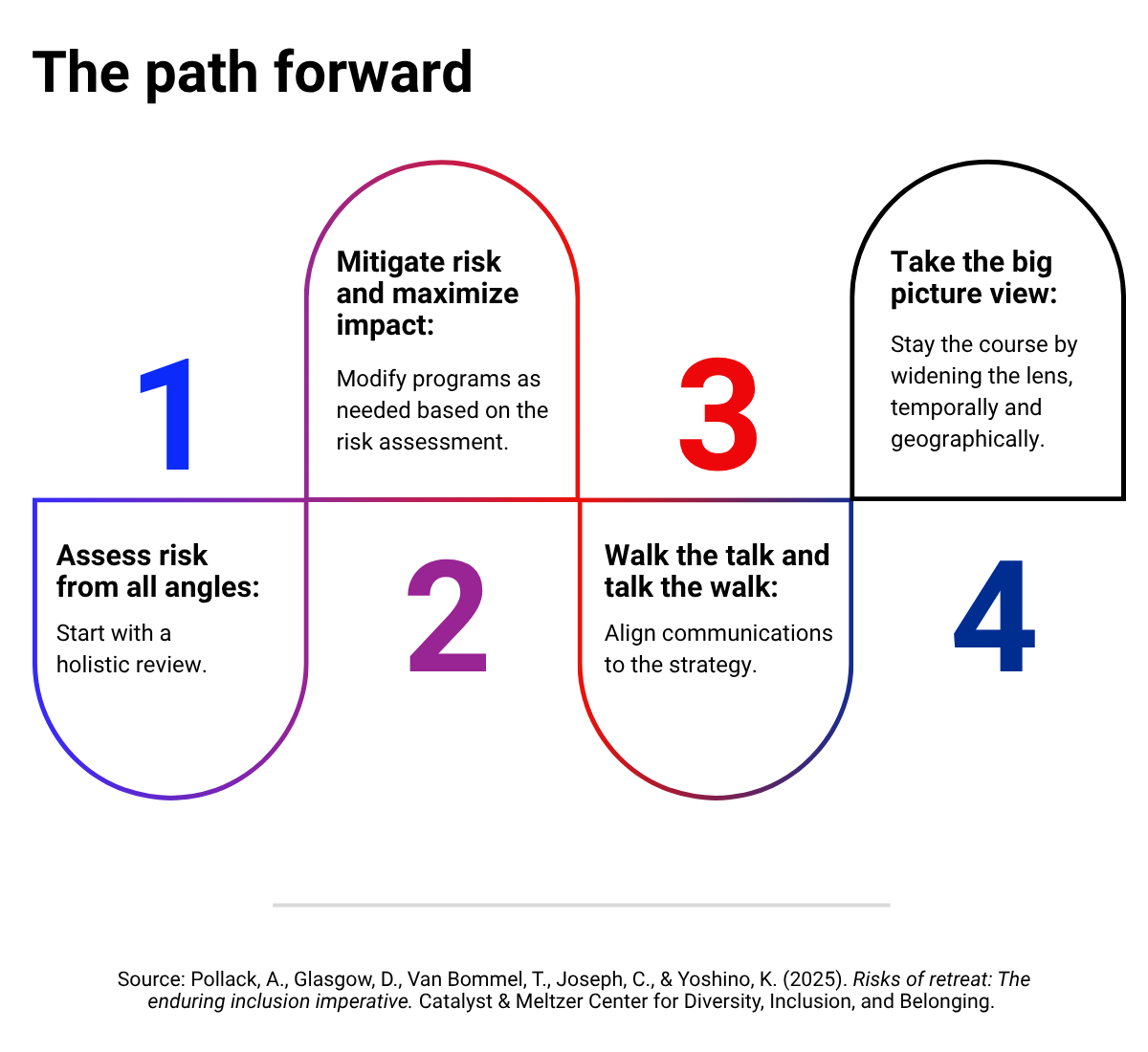
1. Assess risk from all angles
Given the current climate, it is understandable that many leaders are focused on the risks of engaging in diversity, equity, and inclusion activity. However, our survey results underscore the need to conduct a more holistic risk assessment that accounts for legal and social risks from all angles, including the risk of retreat.
We consider the risks in this area to be best represented by a matrix with legal and social risks in two directions: risks associated with maintaining or expanding DEI programs, and risks associated with watering down or abandoning DEI programs.
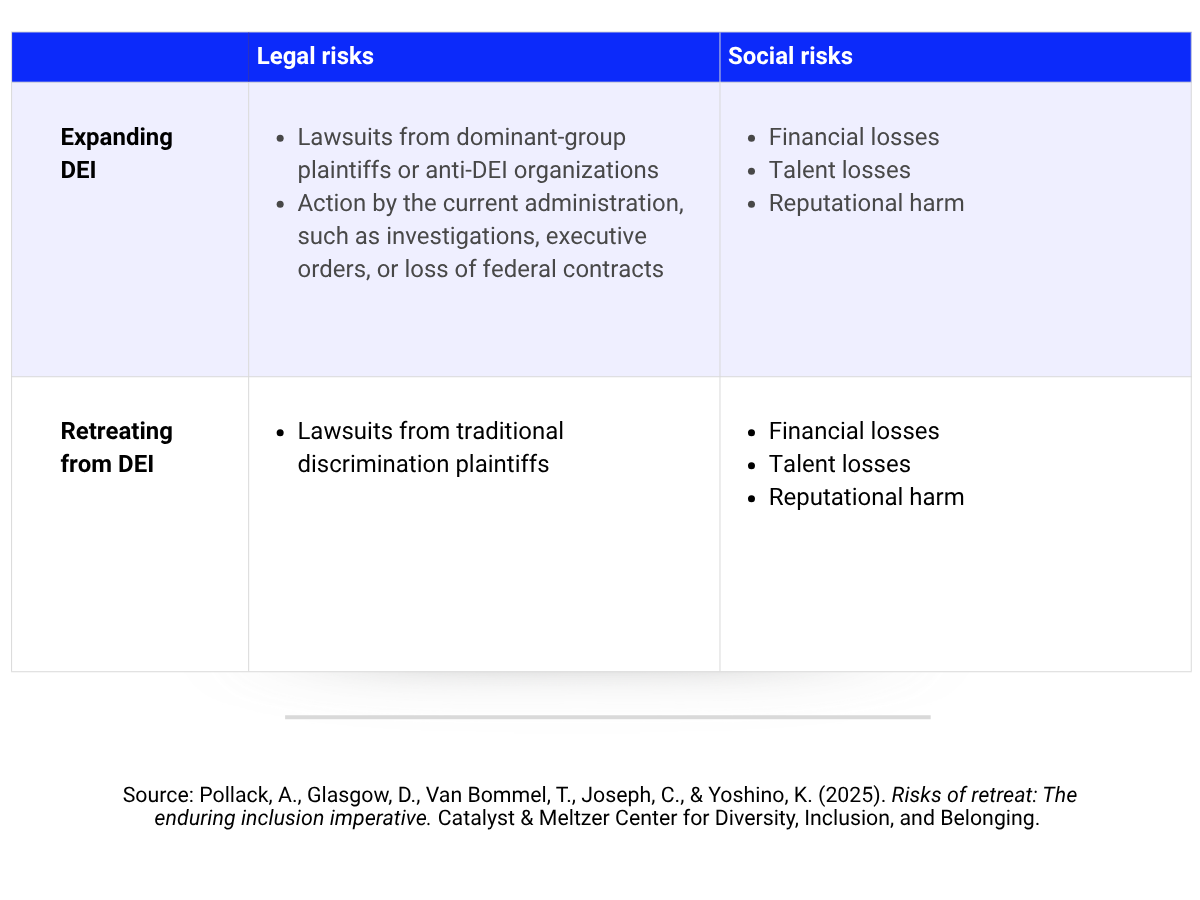
Legal risks
Starting in the top left corner, leaders should consider the legal risks of maintaining or expanding their diversity, equity, and inclusion programs. There is no generic risk of “DEI” as such, since it is an umbrella term encompassing a wide variety of initiatives. Rather, organizations should assess risk program by program.
The Meltzer Center offers a “three Ps” framework to guide such a risk assessment. Each “P” — preference, protected group, and palpable benefit—serves as a criterion for assessing risk. All three elements must be present to create legal risk for an organization:
- Preference refers to whether the program treats some groups differently from others.
- Protected group considers whether the preference is tied to characteristics protected by Title VII or Section 1981, namely race, color, religion, sex (which the Supreme Court since 2020 has interpreted to also encompass sexual orientation and gender identity), or national origin.
- Palpable benefit asks whether the preference gives some benefit to the recipient or causes some harm to the person who misses out, such as preferences in hiring, firing, or promotion decisions.
Based on these factors, a program can fall into one of three risk categories: green (low risk), yellow (moderate risk), or red (high risk). Red means that the program hits all three Ps. Green means that at least one of the three Ps is absent. Yellow means that it is unclear or arguable whether the program hits all three Ps:
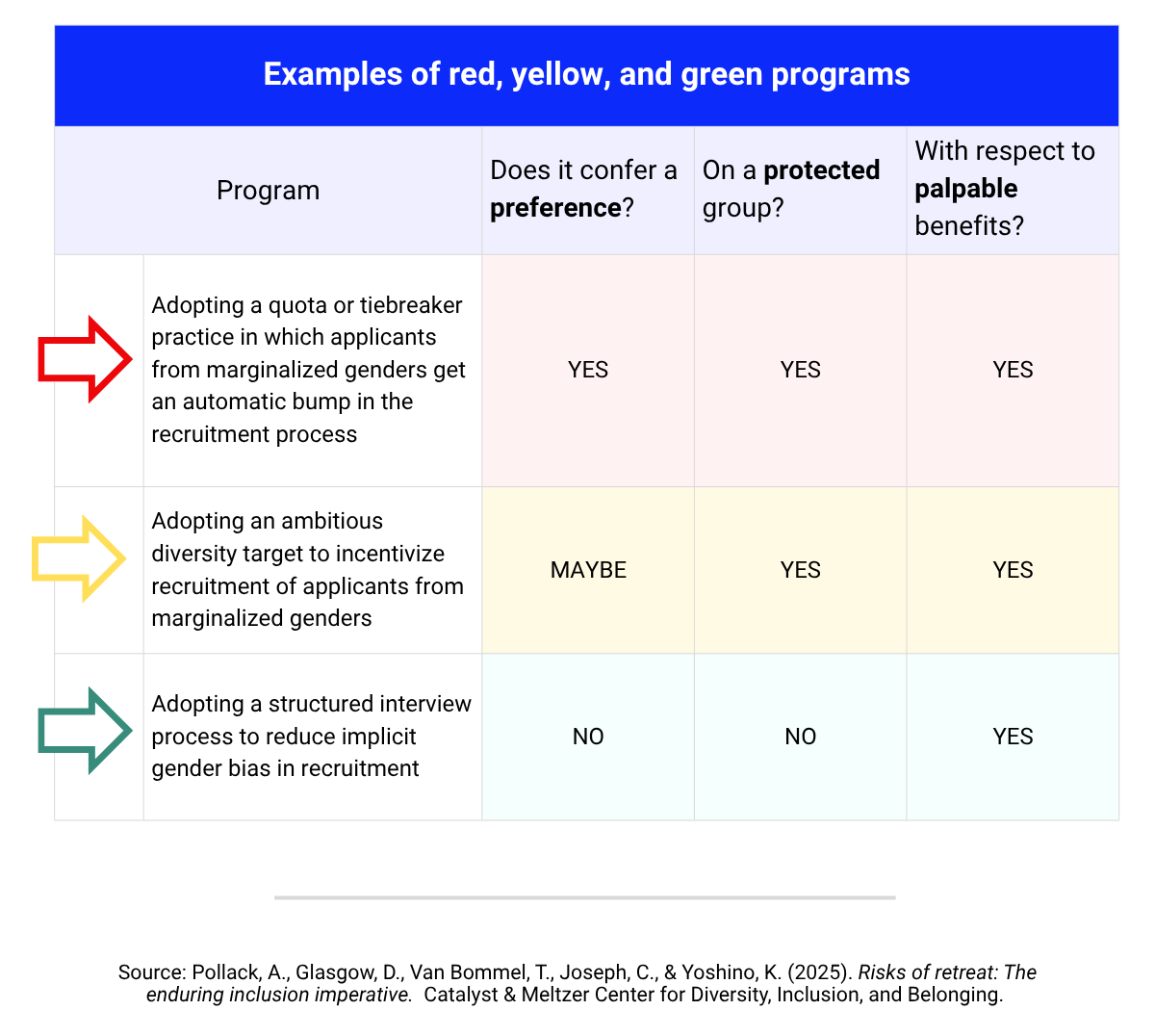
In the top left corner of the matrix, leaders can also consider whether their organization has greater exposure to legal risk on account of being a federal contractor or federal grant recipient.
It is not enough, however, for leaders to only consider the risk of anti-DEI activity. Moving to the bottom left corner, leaders should consider whether failing to implement a diversity, equity, or inclusion initiative — or diluting or abandoning such an initiative — creates legal risks in the other direction.
Even as diversity, equity, and inclusion programs face scrutiny and opposition, retreating from or abandoning these programs also poses significant legal risk. DEI programs encompass a broad array of initiatives designed to eradicate bias in the workplace, increase diversity and belonging, and foster fairness in areas such as promotion, hiring, and performance evaluation. Respondents emphasized the benefits of these programs:
Without these efforts, organizations could inadequately address or inadvertently encourage discrimination and harassment. This outcome would increase the risk of being sued for “disparate treatment” discrimination (treating some groups differently from others) as well as “disparate impact” discrimination (adopting a seemingly neutral policy that has a significantly disproportionate negative impact on some groups).
Social risks
After considering the legal risks in both directions, leaders can move to a similarly balanced analysis of the social risks. Some financial, talent, or reputational risks could arise in the anti-DEI direction, such as if the organization is targeted by an anti-DEI activist as part of a social media campaign. On the other hand, as we have discussed at length in this report, there are significant financial (e.g., boycotts; innovation drain), talent (e.g., recruitment and retention losses), and reputational (e.g., erosion of employee and client/consumer trust) risks associated with retreating from DEI.
Each organization will balance these factors differently. For example, an organization with a more conservative customer base might worry more about the reputational risks of embracing DEI policies, while an organization with a more progressive customer base might weigh more heavily the reputational risks of a retreat.
Regardless of how each organization balances these factors, however, a holistic approach to risk assessment will lead to a more sustainable and thoughtful diversity, equity, and inclusion strategy than fixating on one set of risks.
2. Mitigate risk and maximize impact
Once leaders have assessed risk from all angles, they need to decide what modifications (if any) should be made to their diversity, equity, and inclusion programs.
Mitigate risk
Importantly, just because a specific program presents risks does not mean it needs to be abandoned or modified. The decision often depends on the program’s impact. A program that is achieving tangible success in alignment with organizational values and business goals1 may lead an organization to accept higher legal risk. In contrast, a high-risk but low-impact program may suggest the program is not worth retaining.
If leaders alter a program, they can consider doing so in line with the following shifts, which reduce legal risk under each of the three Ps while preserving the potential for meaningful impact:
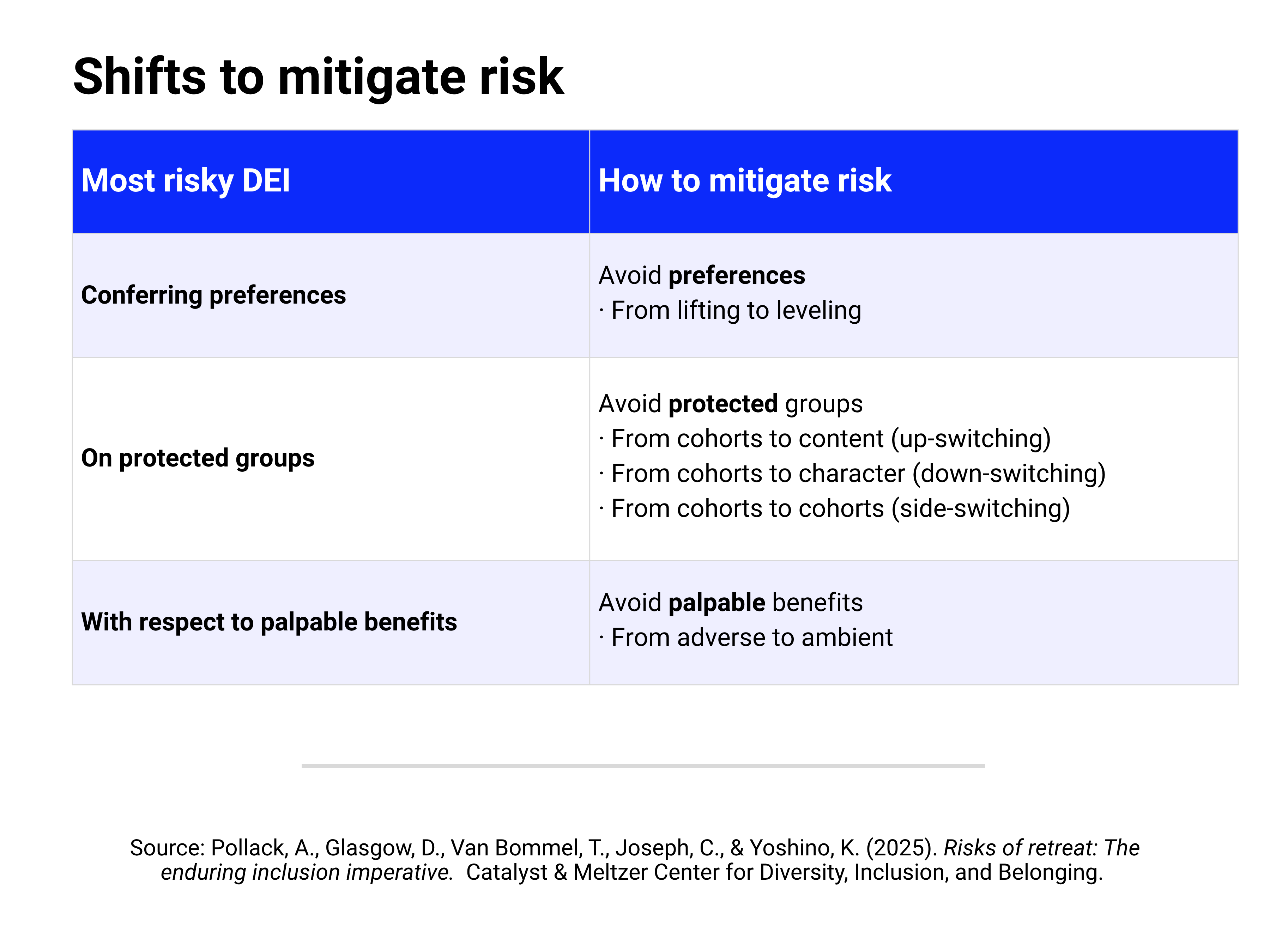
How to mitigate risk
Avoid preferences
Avoid protected groups
Avoid palpable benefits
Maximize impact
Once organizations mitigate risk, they should also ensure their approaches maximize impact. This includes leveraging research-backed and time-tested strategies. For example, consider the below, easily remembered as following a “map."
Following a "map"
Measurement
Accountability
Partnership
3. Walk the talk and talk the walk
After assessing risk and modifying programs as necessary, leaders also need to ensure their communication strategy is aligned with their actions.
Walk the talk
First, leaders need to “walk the talk,” which means matching their actions to their espoused values.3 While our survey shows that leaders hold positive views of their current and future commitments to diversity, equity, and inclusion, they must be careful not to tout this optimistic view without ensuring that the practice on the ground matches the rhetoric. Specifically, they should ensure that:
- Diversity, equity, and inclusion considerations are indeed embedded into everyday workplace practices, such as recruitment, mentorship, work assignment, performance evaluation, and promotion processes. This could be accomplished by, for example:
- Expanding outreach and leveraging new approaches to reach a more diverse talent pool.
- Weaving core principles and behaviors like respect, empathy, courageous communication, and inclusion into leadership expectations.
- Offering training and accountability mechanisms that enable core principles and behaviors to be embedded across the organization.
- Auditing hiring and performance evaluation processes to identify and remove stereotypical assessment criteria.
- Budgets and personnel for diversity, equity, and inclusion are robust and in line with leaders’ avowed “investment” and “commitment” to the work.
- Existing diversity, equity, and inclusion programs are not shuttered or substantively reconfigured unless there is compelling reason to do so based on a holistic risk assessment. If changes are deemed necessary, they should be tailored to address only the specific areas of heightened risk.
Any disconnect between espoused values and organizational action puts organizations at risk of being seen as performative or disingenuous. This perception would have considerable negative implications for employee4 and consumer sentiment.
Talk the walk
Second, leaders need to “talk the walk,” which means clearly and consistently articulating what their organization is doing — and why — with respect to diversity, equity, and inclusion to drive shared understanding and collective buy-in. Recognizing, for example, that some approaches most employees support may be legally problematic, it is essential that leaders explain the rationale behind strategic shifts, including differentiating between compliance-based decisions and strategy-based ones. If leaders effectively “talk the walk,” they can unlock one of the key benefits of DEI gleaned from our survey, as reflected in a Black Gen X woman’s observation that DEI “offers employees the confidence that our company has their best interest at heart.” One mechanism to support this is to develop a charter that clearly outlines the organization’s approach to supporting all talent, driving inclusion, and ensuring fairness.
As noted earlier, Catalyst has identified three common high-level strategies that organizations adopt when responding to the current DEI landscape: fight, flight, and finesse. Survey data and our experience suggests that most organizations are adopting the “finesse” approach. Without effective communication, however, leaders risk a perception gap in which employees interpret “finesse” as “flight.” As we previously described, our survey revealed several troubling gaps between employee and leader sentiment. Employees are much less likely than C-suite or legal leaders to support a “rebrand” of DEI activities or to believe that DEI is currently “embedded” into everyday workplace practices at their organizations, and are more likely to expect that DEI will become less embedded at their company in the future.
These gaps suggest leaders could do a better job of clarifying what changes they are making to their programs, explaining why those changes are necessary, and underscoring the organization’s ongoing commitment to the values of fairness and equal opportunity in the workplace with specificity around how that commitment is being realized. A lack of clear and persuasive communication allows cynicism to fester, which again has considerable negative implications for employee and consumer sentiment.
4. Take the big picture view
Once leaders have completed a risk assessment, modified programs (as necessary) in accordance with that assessment, and aligned their communications and actions to their strategy, we recommend that leaders stay the course and avoid reacting too swiftly to the local political and social currents of the day. The path toward fairer, more inclusive, and more diverse workplaces has never been linear. To make strategic and sustainable long-term decisions, leaders should take a “big picture” view in two respects: temporal and global.
Take a long-term view
Starting with the temporal, we acknowledge that the legal and social environment for diversity, equity, and inclusion work has changed dramatically in the space of just five years — from tremendous pressure to conduct the work after the murder of George Floyd in 2020 to tremendous pressure to retreat in 2025. Similar swings have happened before in US history, such as the backlash following the passage of the Civil Rights Act of 1964 and the backlash to affirmative action in the 1980s. This moment, too, will pass.
Our survey results underscore that the values that caused the upswing in attention to diversity, equity, and inclusion in 2020 endure. Significant majorities of employees in organizations with DEI programs support those programs, and there is near universal support for many of the values that underpin diversity, equity, and inclusion practices. Indeed, panning out to take a more “temporally distant” view highlights that the zeitgeist could easily swing back in favor of DEI — or whatever alternative term organizations choose to adopt. In our survey, Millennials and Gen Z professionals are significantly more supportive of diversity, equity, and inclusion initiatives than Baby Boomers, suggesting that over time, the pressure to maintain and expand DEI programs may increase.
Take a global view
Taking the big picture view also means considering global trends. Our survey was limited to employees in the United States, which prevents us from reporting on data regarding DEI programs abroad. However, many leaders — 46% of our sample — work in organizations that have offices and operations in multiple countries.
In many regions of the world — including Australia, Canada, the UK, and Western Europe — organizations continue to advance fairness and equal opportunity at work, even as the legal and social landscape in the United States becomes more restrictive. For example, the European Union's “Gender Balance on Corporate Boards Directive” requires member states to adopt binding measures to advance women’s representation on corporate boards.5 The EU Pay Transparency Directive, set to take effect in 2026, mandates comprehensive evaluations of compensation packages alongside public disclosure of findings, job applicant salary transparency, and various enforcement measures.6 In 2025, the Australian Parliament passed a new law requiring employers with 500 or more employees to adopt and make measurable progress toward achieving gender equality targets.7 Organizations that react hastily to US developments by pulling back from diversity, equity, and inclusion efforts may:
- Reduce cohesion in the organization’s global brand identity and communications strategy.
- Damage the workplace culture as employees, especially those that routinely interact across borders, perceive the US entity as significantly out of step with global counterparts.
As organizations navigate both the temporal and geographical complexities of this work, we urge leaders to resist the pressure to set their diversity, equity, and inclusion strategy based on the local politics of the moment. Of course, current US pressures around diversity, equity, and inclusion require innovation and adaptation. But the organizations that succeed long term will be those that ground their strategy in organizational values and the practices that decades of research and implementation have shown drive results.